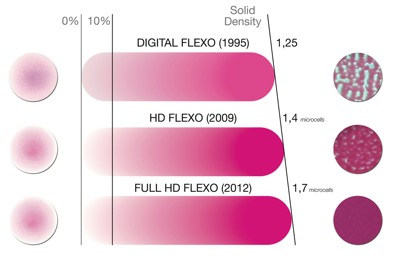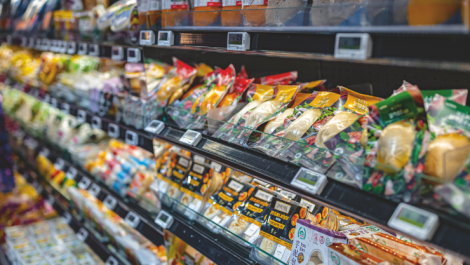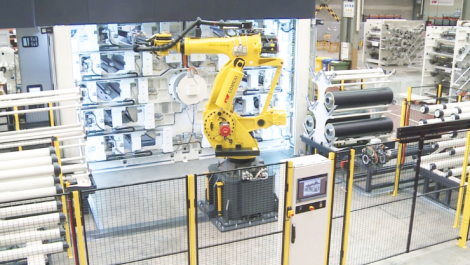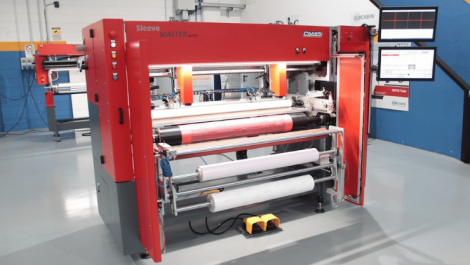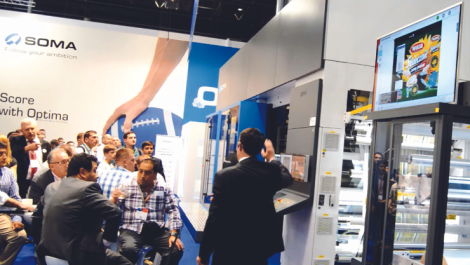Bobst has been focusing on HD flexo printing so that its F&K 20SIX press can handle impression adjustment to 1 micron
Michal Lodej looks at how wide web press manufacturers are interpreting trends in flexo printing to stay at the leading edge of the market whilst remaining price competitive for their customers.
For flexo printers to be successful, efficiencies need to be improved, waste has to be reduced and human error must to be removed. However the press manufacturers need to make sure the presses they sell can adapt to the market printers are working in.
Keeping control
KBA-Flexotecnica has incorporated several features into its wide web gearless CI flexo presses to keep customers at the leading edge of quality flexographic printing.
Automated Impression (AIF) is the company’s own in-house developed print unit positioning system that sets kiss impression without the need for operator intervention. The operator inputs the job parameters into the numerical control system and initiates the AIF sequence, which through the stepping motors moves and senses kiss position between the print and anilox sleeves, and between the print sleeve/substrate locked to the CI (Central Impression cylinder). This operation on average creates only 24 meters of substrate waste and works with the company’s proprietary print registering system, Automated Register (ARF), which uses a dedicated viewing camera and integrated press software.
The latest technological innovation soon to be released by KBA-Flexotecnica is an on-press, real time, spectral colour measurement system which together with high performance 100% video inspection offers consistent print quality and significant reduction of start-up waste. According to the company, these systems ensure accurate performance on almost all films and paper substrates, including transparent supported and unsupported materials.
An inline inspection unit with colour measurement comprises of a spectral sensor, video cameras with lighting, and software to process the image. A central data repository is provided to view print defect information, registration, spectral data L*a*b* and ΔE at maximum production speed and to communicate with other IT systems. The colour measurement systems can exchange data with ink formulation software, where deviations in colour and density result in automatic ink recipe changes.
Inline spectophotometric integrated colour measurement is gradually becoming an essential factor for getting good print results with waste and downtime becoming important factors.
The company has also incorporated a number of what it calls ‘labour easing’ features which are incorporated into its presses. These include Sleeve Pushers to safely eject print and anilox sleeves from wide web mandrels, SpeedyClean automatic wash down and an inking system controlled through new touchscreen interfaces incorporating a dual angle chamber design and the patented Safe Sleeve Change (SSC), where automated shutters enable safe changes of non-printing stations whilst maintaining production and thus shortening critical changeover times.
Being sensitive
Bobst meanwhile has been focusing on high definition printing and fine-tuning the CI unit on its F&K 20SIX press to offer a sophisticated technology for top print quality.
Flexo printing is a highly sensitive process, particularly as regards impression setting and ink transfer. This means that all the components involved in printing must be designed for precision in microns. The company uses servo drive technology and high-precision mechanical guides, so that the press can handle impression adjustments down to 1 micron. Special calibration devices for parallel positioning of the printing units likewise operate with an accuracy of 1 micron.
However, this precision only fully benefits the print quality if, having once been set, the perfect printing position is maintained throughout the entire process, and so the press features additional technical measures to maintain this accuracy. With models featuring large widths or long repeats, for example, the central impression cylinder is driven entirely without gears to ensure the highest possible register accuracy.
In addition to temperature control of the central cylinder, the F&K 20SIX offers an optional temperature compensation system to make sure that plate cylinders and anilox rollers remain in the correct printing position even if the dimensions of the printing unit frames change as a result of temperature fluctuations. Sensors permanently monitor the temperature of the printing unit frames, immediately sending correction signals to the positioning drives of the plate cylinders and the anilox rollers in the event of temperature changes.

F&K 20SIX press
An automatic impression correction system compensates for decreasing ink transfer as production speed increases by dynamically increasing impression. Thanks to the rigid design of the whole CI section, the mechanical precision of the print unit adjustment components and servo drive technology for impression setting, only minimum corrections in the micron range are required. This results in minimum dot gain and consistent print quality throughout the production run for both halftone and solids ensuring that the potential of high definition flexo is fully exploited at all speeds.
Almost all machine manufacturers today offer systems with semi or fully automatic impression and registration adjustment. With the Bobst version, the smartGPS, the company has a system that shifts the entire impression and registration related set-up process to the plate mounting stage, and performs it fully automatically without any operator input required. The system reduces waste to almost zero but also provides the highest possible accuracy and repeatability for impression and register set up.
With the correct impression setting from the start, the press can immediately accelerate to production speed and still produce a high print quality from the first impression.
Keeping on trend
Windmöller & Hölscher has focused its press developments on the market trend that has seen print runs decrease in size but increase in number, by expanding its range with the Miraflex S CI flexo press.
The Miraflex S has been designed specifically for smaller packaging, short runs, quick changeovers, minimal ink and substrate waste and lowered plate costs.
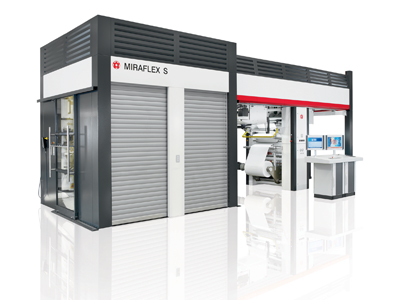
As an eight colour machine, the press is available in widths of 640 mm and 820 mm. Repeats start as small as 250 mm giving lower plate costs for smaller formats. A maximum repeat of 800 mm provides the flexibility to also print larger formats with speeds of 300 or 400 m/min.
The intended applications will determine if the press should be equipped with mono or non-stop turret winders. In either case, both options offer compact, accessible systems for simple logistics and quick roll changes.
Accessibility has played a key role in the development of this press. The Miraflex S offers excellent capabilities for decks and winders, tunnel drying, web monitoring and inspection as well as electronic power supply and control features.
As a member of the Miraflex family, the press can be supplied with the Easy automation modules. Easy-Set reduces waste with precise positioning of the anilox rollers and plate mandrels, while Easy-Reg automatically gets the press into register, and Easy-Col takes care of colour matching and reducing leftover ink while setting up a new job.
One of the most significant developments that the Comexi Group recently presented to the market was the Comexi Flexo F2 MC, suitable for medium to long runs, now available with 10 colours.
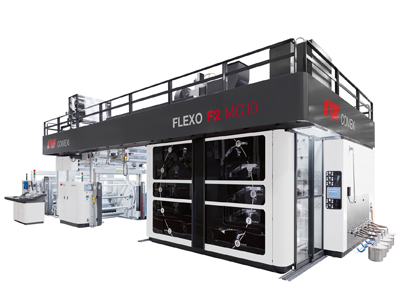
The Comexi Flexo F2 MC
This solution is part of the Comexi Flexo F2 platform, a product range that offers clients the ability to produce print in any market segment.
According to the company, the platform is adaptable, ergonomic and efficient and comes in four different modules. It features on quick job changeovers with new bearing caps and pipeless doctor blades, combined with fast and reliable job settings with automated Cingular modules.
The Flexo F2 WB (water-based) is designed for printing with water-based inks without reducing speed or compromising on quality. This press is available in widths of 1270 mm to 1470 mm, 8 colours and with printing repeats of up to 850 mm at a maximum speed of 500 m/min.
The Flexo F2 MP printer is designed to meet the printing needs of average and long runs in the flexible packaging sector for the retail and wholesale channels. It is available in printing widths of 1270 mm to 1470 mm, 8 colours and with printing repeats of up to 850 mm at a maximum speed of 500 m/min.
A more compact machine, the Flexo F2 MC is better adapted to medium and short runs. It is available in printing widths of 870 mm to 1270 mm, using 8 or 10 colours and with printing repeats of up to 800 mm at a maximum speed of 400 m/min.
Finally, the Flexo F2 MB is optimised for shorter runs. This solution is available in printing widths of 870 mm to 1270 mm, 8 colours and with printing repeats of up to 800 mm at a maximum speed of 400 m/min.
When it comes to productivity, some of the biggest improvements in machinery technologies are those related with the process of the start up of the job, on how to adjust the correct pressure, register and colour. Those processes, if they are not under strict control, may give a significant impact in the result both in the quality of the job and the cost of it.
One improvement from Comexi is the CingularReal2, which is able to take the pressure and register adjustments by considering all of the print run (100% vision) without any dedicated mark. The average waste generated during the adjustment process is between 200 meters and 300 meters depending on printing repeat and number of colours.
Best of both worlds
The latest news from the Uteco Group has revealed that it is adding digital capabilities onto its presses by collaborating with Kodak.
According to the company, a successful demo has been carried out in the group’s technology centre ConverDrome, in Colognola ai Colli in Italy, involving a Uteco Onyx 812 equipped with two Kodak Prosper S20 inkjet heads to produce film for flexible packaging.
The company also found a suitable application for paper printing with its Diamond model, where performances at 800 m/min can be reached with the addition of the variable printed data of a Prosper S30.
Soma Engineering’s range of wide web presses buck the trend slightly by being suitable for label jobs as well as flexible packaging. Available in print widths of 820, 1050, 1270 and 1450 mm, the company’s Premia press has eight printing decks and can print at speeds up to 500 m/min on a wide variety of substrates.
Using Falcon II automatic impression setting and semi-automatic register system, rollers are aligned to enable kiss printing. The impression set up is conducted without printing and using printing plate protection. This makes it possible to go back to the unprinted material and unwind roll and set the register from zero. This system also minimises material waste by assessing the static print register marks. According to Soma total material waste is around 50 metres on set up.
Another option from Soma is the Optima press. This press is designed to make short runs more profitable by becoming more efficient. It has eight printing decks and has a print width of 620 or 820 mm and a roll diameter 800 or 1,000 mm. Designs that include a small area of expensive ink, such as metallics, can be printed using a special ink cartridge, which will only use the ink required on the designs, keeping the cost down of those special inks down to a minimum.
The company has developed the Optima as a mid web press optimised to run label stock paper and film packaging materials, and to bridge the gap between narrow and wide web printing for products such as in-mould and wraparound labels, shrink sleeves, retort stand-up pouches and sachets, as well as paper sacks, cups and plates. It will be on show at Labelexpo in Brussels.
In times of growing demands on print quality, there is automatically an increase in the demands on the performance of a printing press. However, the trend towards efficient printing of a greater variety of products, running smaller jobs and package formats and making quicker job changeovers will continue to be a priority for many flexo printers and will shape the plans of press manufacturers for the very near future.

